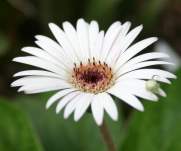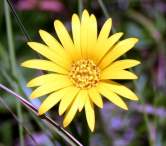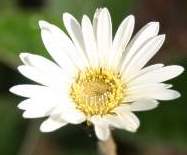Gerbera ambigua
Gerbera ambigua (Cass.) Sch.Bip.
Family: Asteraceae
Common names: pink and white gerbera (E), botterblom, Griekwateebossie (A), moarubetso (SS), ucabazane (Z).
Introduction
Gerbera ambigua is a low-growing perennial daisy which makes an excellent edging plant for a border, or a contrast plant for grasses in a natural garden.

Description
Description
This species is highly variable in terms of leaf structure and inflorescence colour. It is a stemless perennial herb with a basal rosette of leaves emerging from a silky crown. The cylindrical roots are thick and fleshy. Leaves are very variable in shape, size, petiole length and indumentum (covering of hairs).

Flower stalks (up to 35 cm) emerge from the crown and bear a single inflorescence ("flower") which is up to 5 cm in diameter. The ray florets are commonly white with a pinkish underside, or more unusually, yellow, with a coppery underside. The pappus hairs, which give the daisy centre its colour, may be deep purple or cream. Hilliard (1977) grouped the dark-centred forms with white-felted leaf undersides and strongly raised midrib and side veins into a separate species, G. kraussii, which has subsequently been incorporated into G. ambigua by Hansen (1984). Flowers occur mainly from September to December but may be found throughout the year.

Dark centred form

Yellow form

Pale centred form
Conservation Status
Status
Gerbera ambigua is not threatened.
Distribution and habitat
Distribution description
Widespread throughout Africa from the coast to about 1900 m, this species is found in grassland, open woodland and damp areas. The fleshy roots enable it to survive both dry, cold winters and annual fires which are typical of most of the region in which it is found.
Derivation of name and historical aspects
History
The genus Gerbera was named by Jan Gronovius in 1737 for the Gerber brothers: Fr. Gerber, who collected plants in the West Indies , and Traugott Gerber, a German medical doctor baptised in 1710, and the curator of the oldest botanical garden in Moscow . In spite of extensive investigations, no link or reason has been found for the choice of their name for the genus (Ambrosius 2003). The specific name ambigua is derived from the Latin for 'doubtful' or 'uncertain' and is an epithet often applied to highly variable species.
Gerbera kraussii was first collected 'near Pietermaritzburg' by Christian Krauss, a prolific collector of plants in South Africa, between 1838 and 1840.
Ecology
Ecology
The inflorescence of Gerbera ambigua is not specialised for a specific pollinator, and many different flying insects have been observed visiting the flowerheads. However, the most important pollinators are probably Coleoptera (beetles) which feed on the pollen and use the capitulum as a 'rendevous' platform.

Natural hybrids between G. ambigua and the Hilton daisy (G. aurantiaca) have been recorded. These plants have a leaf morphology intermediate between that of the two species, and their ray florets are pink or orange.

Uses
Use
Pounded leaf infusions of Gerbera ambigua are used in Zulu traditional medicine for tapeworm and stomach ache, whereas root infusions are taken orally for coughs. In Zimbabwe, root infusions are used for heart pain and abdominal pain in babies.
Growing Gerbera ambigua
Grow
Propagation of Gerbera ambigua can be done by using either seed or divisions. Seed should be collected at dispersal time and sown within three months. If they can not be sown immediately, they should be kept under normal storage conditions. Viable fruits can be distinguished as they are plump and firm to pressure. Use a well drained medium and keep moist. Germination occurs within two weeks and seedlings can be 'pricked out' as soon as they are large enough.
Large clumps of mature plants can be lifted, preferably in late winter, and gently divided into smaller pieces.
Plant into well-drained and composted soil in full sun or very light shade. Water as little as possible in winter.
All gerberas are prone to fungal discoloration of the leaves from midsummer onwards. This can be treated by spraying with a commercial fungicide.
Gerbera ambigua makes a fine edging plant with its low-growing habit, attractive leaves and pretty white or yellow flowerheads. The dark-centred forms are especially attractive. As it contrasts well with indigenous tufted grasses, it is a good choice for a 'natural' grassland planting. It is also a useful rock garden subject.
References
- Ambrosius, P. 2003. How the Barberton Daisy got its name. Veld & Flora 89(1): 30.
- Hansen, H. 1985. A taxonomic revision of the genus Gerbera (Compositae, Mutisieae) sections Gerbera, Parva, Piloselloides (in Africa ), and Lasiopus . Opera Botanica 78: 5-36.
- Hilliard, O.M. 1977. Compositae in Natal . University of Natal Press, Pietermaritzburg.
- Hutchings, A.1996. Zulu medicinal plants: An inventory . University of Natal Press, Pietermaritzburg.
- Pooley, E. 1998. A field guide to wild flowers KwaZulu-Natal and the Eastern Region. Natal Flora Publication Trust, Durban.
Credits
Isabel Johnson
Natal National Botanical Garden
May 2006
Plant Attributes:
Plant Type: Perennial
SA Distribution: Eastern Cape, Free State, Gauteng, KwaZulu-Natal, Limpopo, Mpumalanga, North West
Soil type: Sandy
Flowering season: Sporadic/All year
PH: Acid
Flower colour: Purple, White, Pink, Yellow
Aspect: Full Sun, Morning Sun (Semi Shade)
Gardening skill: Average
Special Features:
Horticultural zones









Rate this article
Article well written and informative
Rate this plant
Is this an interesting plant?
Login to add your Comment
Back to topNot registered yet? Click here to register.